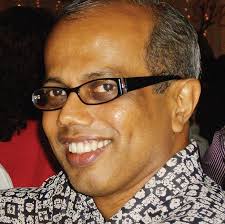Where is the battle ground for a field hospital church?
Not long ago, the Bishop of Rome asked Christians to move out of their comfortable church and parish premises and take the message of God’s love and mercy to those in most need – the poor, the marginalised, the “wounded”.
Oct 20, 2016

By Anil Netto
Not long ago, the Bishop of Rome asked Christians to move out of their comfortable church and parish premises and take the message of God’s love and mercy to those in most need – the poor, the marginalised, the “wounded”.
“The Church does not exist to condemn people,” he said, “but to bring about an encounter with the visceral love of God’s mercy.”
Francis says that for this to happen, Christians need to go outside and look for people “where they live, where they suffer, and where they hope.”
“I like to use the image of a field hospital to describe this ‘Church that goes forth’. It exists where there is combat. It is not a solid structure with all the equipment where people go to receive treatment for both small and large infirmities. It is a mobile structure that offers first aid and immediate care, so that its soldiers do not die.”
To understand the metaphor a bit better, let’s take a closer look at what a field hospital church is, to understand why it is needed.
The concept is often associated with the military battle front, though field hospitals these days are also set up in areas reeling from disaster areas or healthcare emergencies.
Sometimes getting the injured, diseased or wounded to a hospital might take too long or the journey might be too arduous or perilous for the patient.
So field hospitals are set up. This is a mobile medical unit comprising a fairly small number of personnel, who usually bring with them tents and lightweight medical equipment, usually what they can carry with them.
Setting up a field hospital involves pitching up treatment tents, and then the relevant equipment is placed inside each tent. The largest tent would cater to the main focus of the field hospital. It could be to treat trauma or handle orthopaedic cases (in the case of a natural disaster), to treat burns (in the case of a fire), or to treat and control infectious diseases (in the case of an epidemic).
The idea is to bring as high as possible a level of care to a place as close as possible to where the need is greatest and to provide treatment on the spot to the patients.
A field hospital can be set up with in as little as 12-16 hours. Available resources, tents, equipment and medicine, are rushed just behind the frontlines to provide accessible care to where the need is most pressing.
In a field hospital, the personnel make do with whatever equipment and supplies they have, with whatever limited resources they have. They provide urgent treatment to the wounded, stabilise their condition and make them comfortable, providing a refuge from the storm raging around them.
Why does the Church need to act as a field hospital in the world today? Where is the need most felt?
More than four decades ago, economist EF Schumacher anticipated many of the social problems that mainstream “development” would bring about.
Economic policies in developing countries, he observed, had created what he referred to as a “dual economy” — two different worlds for the rich (who would be in a small minority) and the poor (the large majority) resulting in two ways of life existing side by side, the gap so wide that even the humblest member of the rich has a daily income many times higher than the most hard-working member of the poor.
He anticipated, ahead of his time, the obvious “social and political tensions arising from this dual economy”.
The problem, he noted, was that the majority of the population at that time were mostly in the rural areas and small towns while most of the development projects were heavily focused in urban areas. Even today, our best equipped hospitals and schools can be found in the major cities and towns.
This means rural dwellers often migrated to the cities in search of a better quality of life and better-paying jobs. And now in a globalised world, these migrants include workers from less developed nations.
Cities then have to cope with this massive inward migration resulting in many urban areas exhibiting a trend of “excessive urbanisation, towards ‘megapolis’ – with their social facilities were unable to cope.
True, we have made material so-called “progress” if that is judged by the visible changes to the urban landscape e.g. the congested highways and numerous skyscrapers. We can find pockets of our cities where people enjoy lives on par with the developed world. But then these pockets will have to be guarded with security, its residents living in gated communities with CCTV and burglar alarms.
Schumacher noted that in the midst of this affluence can be found large pockets of the underemployed, the unemployables, the drop-outs and the poor. “The dual economy, unless consciously counteracted, produces what I have called a process of ‘mutual poisoning’, whereby successful industrial development in the cities destroys the economic structure of the hinterland, and the hinterland takes its revenge by mass migration into the cities, poisoning them and making them utterly unmanageable.”
So it is on the often invisible periphery, outside the pockets of urban affluence, that we find the greatest need for the Church to minister to the people – the walking wounded of our times, afflicted by all manner of social problems. And this is where the ‘field hospital’ is most needed.
The problem, noted Schumacher, is that our development has focused mainly on material development and financial aid or allocations, as if this alone could provide a quick fix and raise the standard of living.
Real progress, the sort that can uplift the poor and the marginalised, is something that goes beyond a “materialist philosophy” and material opportunities.
For Schumacher, the more important preconditions of success are generally invisible and often overlooked; they cannot be easily planned and bought with money.
Development, he asserts, does not start with goods; “it starts with people and their education, organisation and discipline. Without these three, all resources remain latent, untapped, potential.”
In fact, many countries with all three of these resources, even if they had less material resources, have exhibited higher levels of human development.
Perhaps it is no coincidence that Malaysia’s weak and declining economic performance has coincided with the perception of a long-term decline in its standard of education.
New and sustainable economic activities can only be sustained on the back of a nation and communities which have all three of these resources.
Schumacher emphasised care for the people in economic planning – as they are the primary and ultimate source of wealth. And this is where the Church as a field hospital can play a vital role, especially in urgently ministering to the walking wounded who have fallen through the wide cracks on our road to becoming a materially developed nation.







Total Comments:0